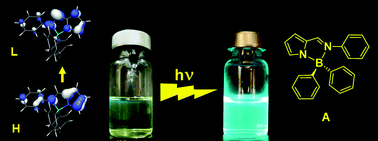Abstract
The three compounds [BPh2(κ2N,N′-NC4H3C(H)![[double bond, length as m-dash]](https://www.rsc.org/images/entities/char_e001.gif) N-C6H5)] (A), [BPh2(κ2N,N′-NC4H3C(H)
N-C6H5)] (A), [BPh2(κ2N,N′-NC4H3C(H)![[double bond, length as m-dash]](https://www.rsc.org/images/entities/char_e001.gif) N-1,4-C6H4-N
N-1,4-C6H4-N![[double bond, length as m-dash]](https://www.rsc.org/images/entities/char_e001.gif) (H)C-H3C4N-N,N′κ2)BPh2] (B) and [BPh2(κ2N,N′-NC4H3C(H)
(H)C-H3C4N-N,N′κ2)BPh2] (B) and [BPh2(κ2N,N′-NC4H3C(H)![[double bond, length as m-dash]](https://www.rsc.org/images/entities/char_e001.gif) N-4,4′-C6H4-C6H4-N
N-4,4′-C6H4-C6H4-N![[double bond, length as m-dash]](https://www.rsc.org/images/entities/char_e001.gif) (H)C-H3C4N-N,N′κ2)BPh2] (C) are blue to green light emitters with average to excellent quantum yields. DFT and TD-DFT calculations were performed in order to understand their behaviour. The geometry of their ground and singlet excited state was optimised, and their absorption patterns and emission were calculated. The large dihedral angles between the planes of the N-aryl and 2-formiminopyrrolyl moieties of the chelating
(H)C-H3C4N-N,N′κ2)BPh2] (C) are blue to green light emitters with average to excellent quantum yields. DFT and TD-DFT calculations were performed in order to understand their behaviour. The geometry of their ground and singlet excited state was optimised, and their absorption patterns and emission were calculated. The large dihedral angles between the planes of the N-aryl and 2-formiminopyrrolyl moieties of the chelating

- This article is part of the themed collection: Dalton Discussion 13: Inorganic photophysics and photochemistry –Fundamentals and applications

 Please wait while we load your content...
Please wait while we load your content...